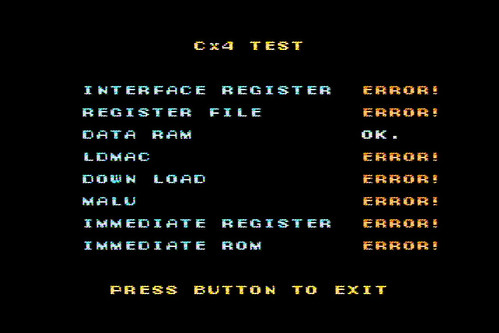Prototype – assembled
I had the Rev.E proto assembled by the end of August – but never got around to showing it off. 😉
Well, here it is.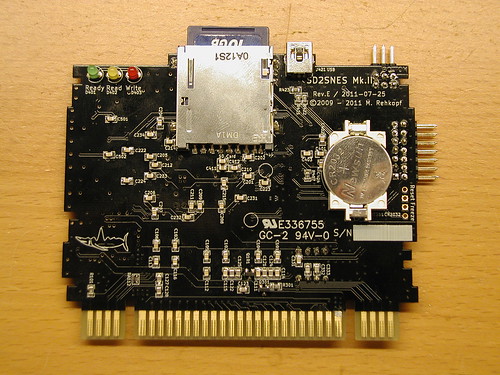
The fat 4MBit SRAM at the top isn’t used yet. Its purpose is to retain save data in case of power failure (before it’s written to SD card), to serve as custom chip work RAM, and probably to store some other status information. Save data is currently stored in PSRAM along with the ROM, and monitored/saved to card from there.
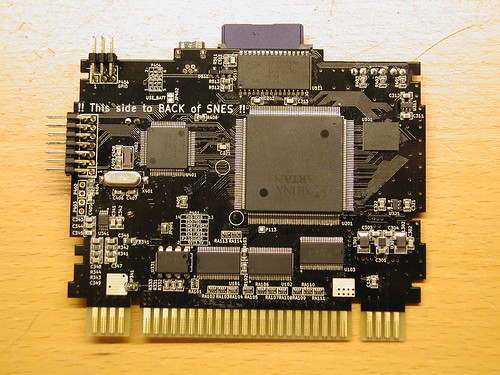
Though the Zeroplus Logic Cube is rather low-end, it’s still a 200MHz, 128kSamples LA that has proven invaluable for all sorts of debugging. The JTAG/UART adapter (not shown) is a run-of-the-mill FT2232 DIP adapter board which plays nicely with OpenOCD. This one I got cheap from Akihabara (thanks to Tobias Diedrich!).
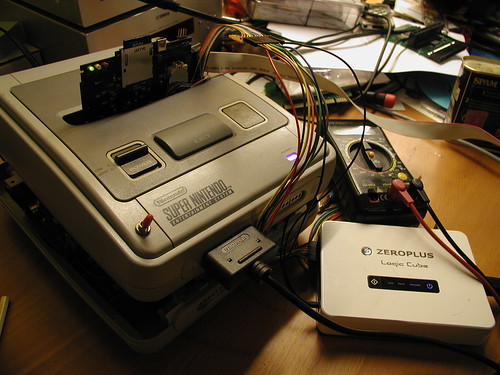
Latest prototype PCBs arrived
Quick update, the latest prototype PCBs arrived a couple of days ago. Assembly is in progress. This revision reduces audio noise from the DAC. This was a problem with 1CHIP SNESes which introduce much more noise, presumably due to their much steeper signal edges on the bus. The noise disappears when using a “custom chip game” case with the additional grounding prongs. I didn’t want to rely on that though, hence the hardware update. 😉
Here they are. I hope this is the last hardware revision, all those prototype PCBs are getting expensive…
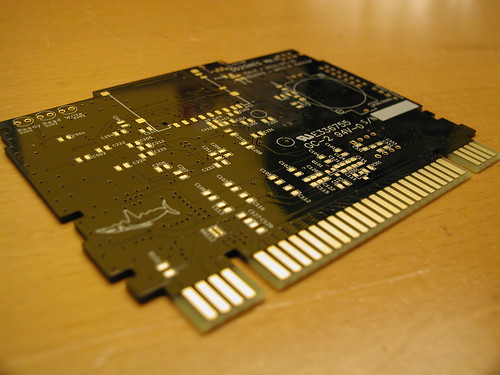
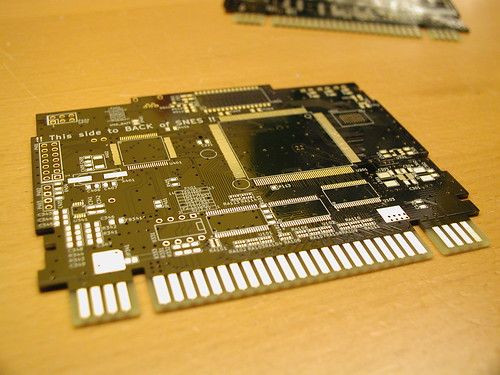
A small recap, part 2
So the hardware was pretty much done at that point. Yet I did a complete redesign of the hardware. Why? Multiple reasons:
- Segher reverse engineered the SNES CIC and published the disassembled ROM dump of the D411 (US/JP CIC). I figured out the seeds of the D413 (EU CIC) – just one nibble was changed – and made a PIC based CIC replacement with automatic region fallback. sd2snes now worked on any unmodified SNES. (Also a counterpart was created later to replace the original CIC in the console itself – with additional features like switchless 50/60Hz switching. See the SuperCIC page.)
- MSU1 – byuu came up with the 21fx specification, later renamed to MSU1, that allows streaming of up to 4GB of data and CD-quality audio playback from mass storage. The present hardware would not have been able to stream data from card at the rate required by the spec. Also a DAC was needed to input audio to the SNES’s cartridge slot. Additionally the bonus extension pins of the cartridge had to be added again to accomplish this – to access the line-in and to synchronise audio with the SNES master clock to maintain A/V sync during video playback.
- RAM cost and space requirement. The 64 MBits of SRAM were comprised of four 16 Mbit SRAM chips at ~14€ each. A 128Mbit PSRAM is now used. There was a catch though – these chips are only available in BGA packages. A subproject was initiated to modify a pizza oven to work as a makeshift reflow oven. I was skeptical at first but it proved to work better than expected.
- A second RAM bus was added. This was necessary to allow for parallel access to the ROM and battery/cartridge RAM areas. Some custom chips like the SuperFX require this. The second RAM is 4Mbits of SRAM. The increased number of required I/Os required changing the FPGA to a bigger package (PQ208).
- Due to MSU1 the loading speed had to be improved. A more advanced microcontroller (ARM Cortex M3 @100MHz) was used to replace the slow 8-bit AVR. This chip also includes an RTC so a battery holder was added to maintain the RTC. The battery doubles as a backup battery for the 4Mbits of SRAM. That way saved games can be preserved even when a blackout occurs before the automatic save feature can write to SD card.
- I replaced Eagle with KiCAD as the EDA tool – it is free as in speech, less restricted, and slightly more usable.
- Much higher loading speed (9MB/s)
So that was a pretty big overhaul. The current result looks like this:
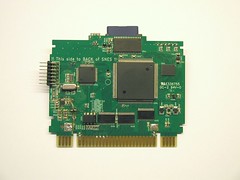
Development is now going on to implement the enhancement chips. The following are currently supported:
- S-RTC
- BS-X / Satellaview
- DSP1
- DSP1b
- DSP2
- DSP3
- DSP4
- ST0010
- MSU1
A small recap, part 1
Development of sd2snes began in April 2009, inspired by sd2iec (hence the name).
Since 2001 I had been tinkering around with modified SNES cartridges, removing the ROMs to replace them with small self-made flash modules (usually a 29F032 or 29LV640 soldered on a small PCB with a pin header). They looked like this:

Even back then the idea to make a complete flash based cartridge from scratch was lingering in the back of my head. But it seemed too difficult to do for me. It also seemed impossible to implement new features, like additional memory maps, custom chips, etc. afterwards with the flexibility I wanted.
Fast forward to 2009. With time, more powerful yet affordable FPGAs had become readily available. Also sd2iec was released which provided ready-made SD card support (SPI mode).
The first prototype was constructed on breadboard with lots of self made adapters, most notably the FPGA->breadboard adapter, with on board power supply and configuration jumpers.

Hardware specs of the breadboard were:
- Spartan3 FPGA, 144 pins
- ATMega644 MCU @12MHz (64kB flash, 4kB RAM)
- 16MBits of SRAM
- SPI SD interface, max. ~1.5MB/s (read)
- FPGA is configured by the MCU, loading a bit file from SD Card
- Placeholder for original CIC (lockout chip), only one region possible without modding the console
This design was more or less adapted for the first PCB prototypes (all of Mk.I), the only difference being more SRAM (64MBits). Loading was somewhat slow due to SPI mode and a maximum 6MHz SPI clock from the AVR. Later the FPGA was used to load blocks to RAM directly, increasing the read speed to ~1.5MB/s. SNES master clock (Pin 1) was used as a clock source for the FPGA. It proved unreliable (the DCM just stopped working at random) so in later revisions (and all of Mk.II) the AVR clock output was used to clock the FPGA. This resulted in the last revision of Mk.I having the additional groups of slot pins removed entirely.


Coming up: SuperCIC, MSU1, timing perils
